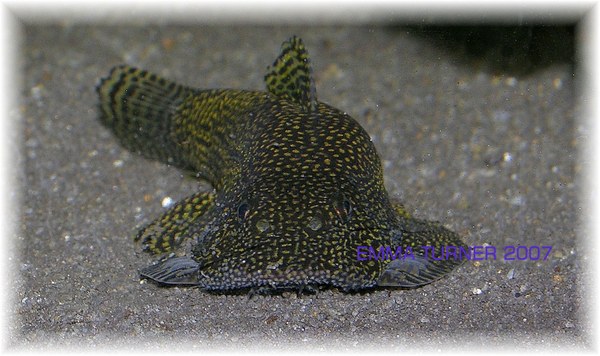The Spawning of Sewellia sp. 'spotted' & fry growth development

Back in May/June 2006, I was thrilled to acquire a batch of a beautiful undescribed Sewellia species from my Vietnamese supplier, which they listed at the time as 'Sewellia Special'.
These were said to occur in a location which overlaps that of the natural range of Sewellia lineolata. Whilst we do not yet have definitive proof of this, it does fit well with the fact that occasional shipments of Sewellia lineolata have since yielded the odd contaminant in the form of Sewellia sp. 'spotted'.
Sewellia sp. 'spotted' (or 'Spotties' as we affectionately refer to them here on Loaches Online) are a much bulkier and larger growing species compared to S. lineolata. Most of my specimens are over 2.75" TL with an impressive girth and height, particularly the mature females. They literally dwarf the adult S. lineolata.
This photograph, taken early 2007, of the underside of one of the male specimens, clearly shows the bulky proportions against the tape measure . Note the elaborate reticulations that envelop the head area:

This is an incredibly attractive loach, which displays a showy shimmer of fine golden spotted markings all over the body and most of the fins. Under certain lighting conditions, these markings are simply dazzling. It is a bit of a shame, therefore, that this has turned out to be a fairly reclusive species, preferring to graze in shadier areas of the aquarium and typically does not grace us with its presence much until feeding time (unless under blue moon lighting). And when it comes to food, this large hillstream loach species is not fussy and will be one of the first fish to reach the rations and is not afraid to defend it with vigour!
Below is a photograph taken at feeding time, which shows the differences between this species and S. lineolata. The S. lineolata in the picture is a large adult, which shows how sizeable the Spotties are:

My successful spawning of S. lineolata in Summer 2006 is documented in this article. During the time that my S. lineolata were spawning again in December 2006, the Sewellia sp. 'spotted' also began to breed, now well settled into the tank and perhaps spurred on by the same excellent water conditions and the presence of hormones floating about in the water.
The following photograph shows a mature male specimen, with the most impressive sets of tubercles and pectoral fin fences ever! Clearly ready to impress the ladies.

And here is one of the mature females, which as you can see, possesses no tubercles/pectoral fin fences and is of a fuller appearace:

It wasn't until I was relaxing in front of the tank, observing my newly transferred S. lineolata fry - found in the external filter and grown on to a decent size in a separate aquarium - that I actually realised this. I suddenly caught a glimpse of a tiny, but intensely colourful stripy fish moving about on the substrate. It was no more than 6mm TL and had a bright yellow base colour with several jet black vertical bars.
Naturally, because of its diminutive size, I was worried for its safety, but luckily it managed to avoid all the predators in the tank, growing quickly and going through the most amazing pattern transformation, which I have documented in a composite picture below.
Stripes turning into Spots:

The whole exciting, unfolding saga of the development of the fry can be viewed in this Loach Forum thread: http://forums.loaches.com/viewtopic.php?t=3995
Water parameters at the time of the first spawning of this species were as follows:
pH: 6.6, dH: 6 degrees, TDS: 150, Temperature: 78 deg F
Indian Almond Leaves (Terminalia catappa) are used in the external filter & replaced every 5 weeks.
Several more fry have since been found both in the aquarium (River Tank style) and in the external cannister filter and are growing well. Long may it continue!
Some interesting points worth noting:
- Sewellia sp. 'spotted' fry grow to a longer/wider size much more quickly than S. lineolata fry. My first Spotted fry (found December 2006) had overtaken the S. lineolata fry (found June 2006) by the end of January/beginning of February 2007.
- Although the Spotties grow more quickly in most respects, the pectoral and ventral fins are actually slower to develop than in S. lineolata and so the fish do not start 'clinging' to the decor and glass for some time.
- The fry of Sewellia sp. 'spotted' are very up-front and not at all cryptic like the adults.
- The opposite can be said of S. lineolata where the fry are shy in comparison to the up-front adults.
- The fry of both Sewellia species possess barbel-like appendages which shorten as the fish mature.
- A small cool water change seems to trigger both species of Sewellia into spawning mode. The males 'circle' the females in an elaborate courtship dance, and if the male is accepted by the female, the pair will rise up into the water column where the eggs/milt will be scattered into the current.
- Although the eggs have never been seen in any great detail, they are of tiny enough proportions to easily fit through the standard slotted intake strainers which come with Eheim external filters.
And finally: if you maintain groups of Sewellia species in your own river-tanks, do make sure you check the contents of your external cannister filters on a regular basis.

I do hope that you have enjoyed reading this report,
Emma Turner
![]()
Document Actions

